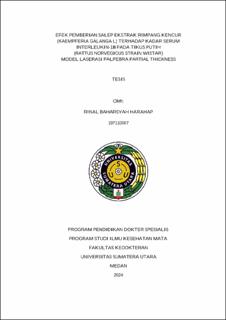| dc.description.abstract | Background: Ocular trauma in the form of lacerations on the eyelid or palpebral
region is the most commonly encountered clinical finding. The use of medicinal
plants such as the rhizome of Kaempferia galanga (KG), containing significant
bioactive components like ethyl-p-methoxycinnamate (EPMC), as a therapeutic
modality to enhance wound healing through its contained anti-inflammatory
effects, has become a crucial focus in modern medicine. This study aimed to
evaluate the influence of applying an extract ointment of KG on an experimental
animal model of eyelid lacerations concerning the levels of interleukin-1β (IL-1β)
in the serum, theoretically associated with the inflammatory process.
Methods: This analytical experimental research employed a randomized post-test
only control group design involving a cohort of Wistar strain white rats (Rattus
norvegicus). Administration of the KG extract ointment at concentrations of 5%,
10%, and 15% was performed on a partial thickness eyelid laceration model, then
compared with positive control (gentamicin ointment), negative control, and no
intervention (sham) groups. Evaluation was conducted on serum IL-1β levels after
a 5-day treatment period.
Results: No statistically significant differences (P > 0.05) were found in each test
group (n=5) following the interventions over 5 days. The lowest IL-1β levels were
observed in the 5% KG group (10.23 ± 2.44 ng/ml), while the highest was in the
10% KG group (13.48 ± 2.27 ng/ml). The one-way ANOVA test conducted also
concluded that no groups significantly differed from the sham population (11.09 ±
4.35 ng/ml).
Conclusion: Administration of the KG extract ointment at any concentration did
not affect the serum IL-1β levels in the experimental model of eyelid lacerations in
animals. | en_US |




